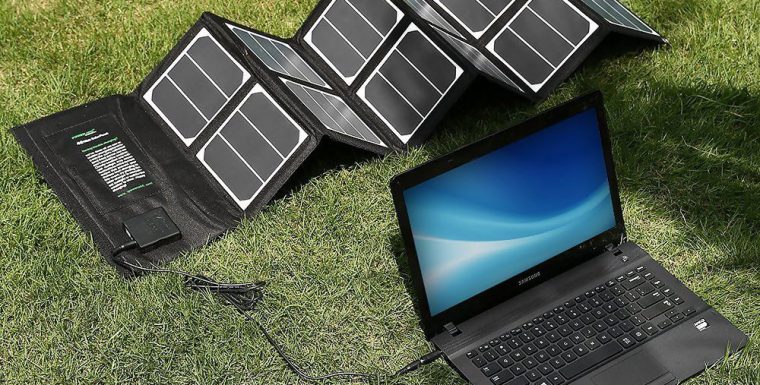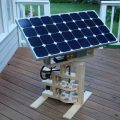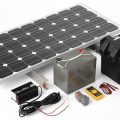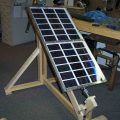By EM Beck
This may seem incredible and impossible to do, but many computer technophiles are going “green” when they travel with a laptop in tow these days.
If you are familiar with “extreme” or remote computing this may not seem too far fetched. Let’s not forget that many professionals enjoy rugged recreational activities, but just can’t always leave the office behind.
The idea of solar power for remote computing is finally catching on. It is working for everyone from the cross-country cyclist and weekend camper, to regular working stiffs that have to rough it on the job.
[easyazon_image align=”left” height=”160″ identifier=”B00RFCVR62″ locale=”US” src=”http://solarpowerstore.xyz/wordpress/wp-content/uploads/2016/10/41e7jF9bO3L.SL160.jpg” tag=”solar-power-store-20″ width=”160″]Solar power is not just a possibility, but could be a necessity for those that go remote. Solar panels are used to collect solar energy for direct use or storage in batteries to power up later.
Here is how solar, or photovoltaic energy is realized from the “How Stuff Works” website. If you are not an electrical engineer or scientist of some sort, don’t be surprised if this does make light bulbs go off in your head. You can always come back and do further research on the Internet.
“The solar cells that you see on calculators and satellites are photovoltaic cells or modules (modules are simply a group of cells electrically connected and packaged in one frame). Photovoltaics, as the word implies (photo = light, voltaic = electricity), convert sunlight directly into electricity. Once used almost exclusively in space, photovoltaics are used more and more in less exotic ways. They could even power your house. How do these devices work?
Photovoltaic (PV) cells are made of special materials called semiconductors such as silicon, which is currently the most commonly used. Basically, when light strikes the cell, a certain portion of it is absorbed within the semiconductor material. This means that the energy of the absorbed light is transferred to the semiconductor. The energy knocks electrons loose, allowing them to flow freely. PV cells also all have one or more electric fields that act to force electrons freed by light absorption to flow in a certain direction. This flow of electrons is a current, and by placing metal contacts on the top and bottom of the PV cell, we can draw that current off to use externally. For example, the current can power a calculator. This current, together with the cell’s voltage (which is a result of its built-in electric field or fields), defines the power (or wattage) that the solar cell can produce.”
To continue, we will discuss the smaller hand held devices for cell phones and PDAs, all the way to powerful self-contained and fully remote commercial solar systems. Here are several links that describe the use of solar power for mobile computers and other wireless devices from the Do-It-Yourself perspective.
It is amazing what is already available and out in the marketplace for solar power options. As energy costs and energy conservation continue to garner interest as mainstream issues, we should see the rapid development of solar integrated design features. Soon it may be a standard feature and part of everyday portable computers.
Let’s hope so, because going green is good for everyone, not just an intriguing proposition for rugged notebook users and remote computing,
Hand Held Solar Kits
[easyazon_image align=”right” height=”160″ identifier=”B018TY8ZYQ” locale=”US” src=”http://solarpowerstore.xyz/wordpress/wp-content/uploads/2016/10/41wg95pGeqL.SL160.jpg” tag=”solar-power-store-20″ width=”160″]Solar kits are designed to be self-contained. They combine solar cells, rechargeable batteries, and a wide selection of cables. These won’t power a portable laptop yet unless it’s a miser on energy, but they will keep you connected with a limitless power supply for your cell phones, Smart phones, PDAs, and smaller devices. As long as the sun is shining, or the batteries are charged up, you will have power.
Many purists will argue anything solar is not really “green”, either because it will never be energy positive (will never generate more power than it took to manufacture), or because it has a battery, making it environmentally unfriendly by default.
Arguments aside, at issue for rugged and remote users is a reliable power source, and having some sense of being connected. So, solar charging devices can be considered either as “convenience efficient” or “emergency efficient”. Don’t take this as a challenge to engineer types that will want to get their slide rules out, just a notation that these solar kits are an honest attempt at the “plus” column for reducing the human carbon footprint. Wider adoption and acceptance of new technology usually results in greater efficiencies.
Two promising examples that have had good reviews are the reasonably affordable products from Solar Style Dot Com, and the pricier Solio Dot Com. Do a search on YouTube and you will find many videos of Solio in action. If it did not work, we would know it by now.
Portable Solar Power Docking Stations
The idea of using solar power in remote situations is nothing new. The question for us is how well, and how fast, a solar power station will power up your notebook or laptop. Other considerations are the size, weight, and portability. You will find many products in this category, but few online reviews that confirm that these products will actually perform as advertised. The best source I have found for honest reviews in this regard is TreeHugger.com.
There are very few winners in the category of a portable solar power docking station to efficiently run a laptop computer. One that does get good reviews on the subject is the “PowerDock System”.
Do an online search for PowerDock System, and you will find many retailers and dealers at different price points. So be patient and shop around. Your Mobile Desk Dot Com is the best resource for a complete descriptions of the PowerDock product line. These include from the least expensive to the most expensive: PowerDock Lite, PowerDock Basic. PowerDock Executive, and PowerDock Elite.
Power Dock Systems are relatively expensive, and range in price form a few hundred dollars on up to $450.00. The PowerDock is an attractive product design an weighs in from 5 to 13.5 pounds.
Another potential winner is the Notepower Solar Laptop Charger from Sierra Solar Systems. You will see the Notepower Solar Charger pop up along with the PowerDock in a search engine query for these type of solar products. Plug in the SmartAdapter with extended 10 foot cord included, and start charging or topping off your computer battery as long as sunshine is available.
Once again, this is not a review recommendation, but the Notepower has had favorable comments by TreeHugger.com and other reliable sources, giving no pause to mention it here. The 3 lb. Notepower is not designed with a storage battery, but the 20-30 watts of power will charge and run most laptop computers, according to the specs.
You may not consider the Notepower as a true solar docking station, but it is an attractive portable solar package for a temporary power solution. Originally priced around $250.00.
Commercial and Military Grade Solar Power Systems
[easyazon_image align=”left” height=”160″ identifier=”B00M16KLLE” locale=”US” src=”http://solarpowerstore.xyz/wordpress/wp-content/uploads/2016/10/61IaHdoZHL.SL160.jpg” tag=”solar-power-store-20″ width=”160″]Some of the best remote solar power systems are designed to meet military standards. You could even say that anything designed for military use is pretty much guaranteed to perform. These systems will compliment anything in the fully rugged notebook computer category.
Energy Technologies, Inc. in Ohio, USA makes a wide assortment of military standard power equipment for field use. Things like field deployable inverters, converters, UPS, engine-generators, along with solar power stations with the trade name Tactical Solar Products.
The product features for these Tactical Solar Products include various combinations of charge controllers, power storage batteries, AC/DC power adapters, multiple DC outputs, and a large selection of folding solar panels. The specific product line is the Solar Suitcase I, Solar Suitcase II, Solar Suitcase III, Solar Suitcase IV, along with the folding SolarTacticalPanels.
Solar Suitcases I-IV can charge Lead Acid, Li-Ion, NiCad, NiMH & other types of rechargeable batteries. The nearly bullet proof folding solar collection panels are available from a 15 Watt to a hefty 330 Watt output panel set. This is “green power”, but you are out of luck if you prefer a color other than the two camouflage patterns available.
You will have to call ETI for costs, as product pricing is not published on the ETI websites.
Computing Solar Power Wrap-up
We have looked at several of the many possibilities for solar power, and going “green” with remote computing. The possibilities are becoming more reliable and starting to make more economic sense. You can try to go solar and Do-It-Yourself, or for the less technically inclined there is a wide range of retail and commercial applications for sale. We have attempted to highlight a few of the proven DIY options, and find some of the readily available products, and systems from various online reviews.
Some of the solar power resource websites you might want to keep an eye on include: Altapower.com, RadioLabs.com, and CTSolar.com. There obviously are many more you will find now and in the future with your favorite search engine.
As computing devices become smaller and more mobile, and with nascent technology soon to push the boundaries of wireless networks, solar power could prove to be a factor in your computing future.
Article Source: Solar Power for Notebook and Laptop Computers







